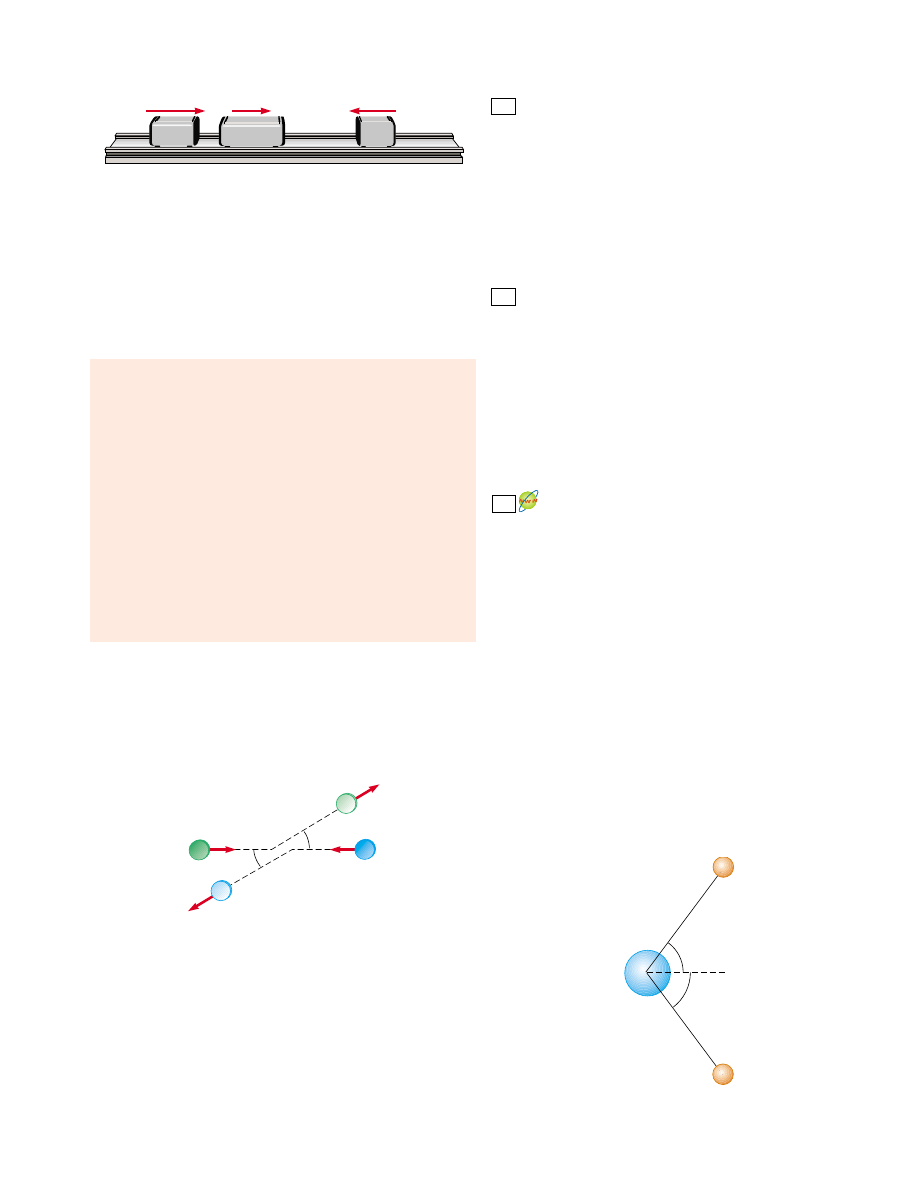Physics For Scientists And Engineers 6E - part 72

Problems
285
A billiard ball moving at 5.00 m/s strikes a stationary ball
of the same mass. After the collision, the first ball moves,
at 4.33 m/s, at an angle of 30.0° with respect to the origi-
nal line of motion. Assuming an elastic collision (and ig-
noring friction and rotational motion), find the struck
ball’s velocity after the collision.
34.
A proton, moving with a velocity of v
i
ˆi, collides elastically
with another proton that is initially at rest. If the two pro-
tons have equal speeds after the collision, find (a) the
speed of each proton after the collision in terms of v
i
and
(b) the direction of the velocity vectors after the collision.
An object of mass 3.00 kg, moving with an initial velocity of
5.00
ˆi
m/s,
collides with and sticks to an object of mass
2.00 kg with an initial velocity of
"
3.00
ˆj
m/s
. Find the fi-
nal velocity of the composite object.
36.
Two particles with masses m and 3m are moving toward
each other along the x axis with the same initial speeds v
i
.
Particle m is traveling to the left, while particle 3m is travel-
ing to the right. They undergo an elastic glancing collision
such that particle m is moving downward after the collision
at right angles from its initial direction. (a) Find the final
speeds of the two particles. (b) What is the angle & at
which the particle 3m is scattered?
An unstable atomic nucleus of mass 17.0 * 10
"
27
kg
initially at rest disintegrates into three particles. One of
the particles, of mass 5.00 * 10
"
27
kg, moves along the y
axis with a speed of 6.00 * 10
6
m/s. Another particle, of
mass 8.40 * 10
"
27
kg, moves along the x axis with a
speed of 4.00 * 10
6
m/s. Find (a) the velocity of the
third particle and (b) the total kinetic energy increase in
the process.
Section 9.5 The Center of Mass
38. Four objects are situated along the y axis as follows: a
2.00 kg object is at # 3.00 m, a 3.00-kg object is at # 2.50 m,
a 2.50-kg object is at the origin, and a 4.00-kg object is
at " 0.500 m. Where is the center of mass of these objects?
39.
A water molecule consists of an oxygen atom with two hy-
drogen atoms bound to it (Fig. P9.39). The angle between
the two bonds is 106°. If the bonds are 0.100 nm long,
where is the center of mass of the molecule?
37.
35.
33.
30.0˚
30.0˚
Figure P9.31
53
°
53
°
0.100 nm
0.100 nm
O
H
H
Figure P9.39
Section 9.4 Two-Dimensional Collisions
28.
A 90.0-kg fullback running east with a speed of 5.00 m/s is
tackled by a 95.0-kg opponent running north with a speed
of 3.00 m/s. If the collision is perfectly inelastic, (a) calcu-
late the speed and direction of the players just after the
tackle and (b) determine the mechanical energy lost as a
result of the collision. Account for the missing energy.
29. Two shuffleboard disks of equal mass, one orange and the
other yellow, are involved in an elastic, glancing collision.
The yellow disk is initially at rest and is struck by the or-
ange disk moving with a speed of 5.00 m/s. After the colli-
sion, the orange disk moves along a direction that makes
an angle of 37.0° with its initial direction of motion. The
velocities of the two disks are perpendicular after the colli-
sion. Determine the final speed of each disk.
30.
Two shuffleboard disks of equal mass, one orange and the
other yellow, are involved in an elastic, glancing collision.
The yellow disk is initially at rest and is struck by the or-
ange disk moving with a speed v
i
. After the collision, the
orange disk moves along a direction that makes an angle &
with its initial direction of motion. The velocities of the
two disks are perpendicular after the collision. Determine
the final speed of each disk.
31.
The mass of the blue puck in Figure P9.31 is 20.0% greater
than the mass of the green one. Before colliding, the pucks
approach each other with momenta of equal magnitudes
and opposite directions, and the green puck has an initial
speed of 10.0 m/s. Find the speeds of the pucks after the col-
lision if half the kinetic energy is lost during the collision.
5.00 m/s
3.00 m/s
–4.00 m/s
10.0 kg
4.00 kg
3.00 kg
Figure P9.27
32. Two automobiles of equal mass approach an intersection.
One vehicle is traveling with velocity 13.0 m/s toward the
east, and the other is traveling north with speed v
2i
. Nei-
ther driver sees the other. The vehicles collide in the inter-
section and stick together, leaving parallel skid marks at an
angle of 55.0° north of east. The speed limit for both roads
is 35 mi/h, and the driver of the northward-moving vehi-
cle claims he was within the speed limit when the collision
occurred. Is he telling the truth?